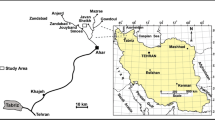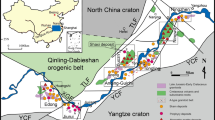Abstract
Hydrothermal iron ores at Divriği, east Central Anatolia, are contained in two orebodies, the magnetite-rich A-kafa and the limonitic B-kafa (resources of 133.8 Mt with 56% Fe and 0.5% Cu). The magnetite ores are hosted in serpentinites of the Divriği ophiolite at the contact with plutons of the Murmano complex. Hydrothermal biotite from the Divriği A-kafa yield identical weighted mean plateau ages of 73.75 ± 0.62 and 74.34 ± 0.83 Ma (2σ). This biotite represents a late alteration phase, and its age is a minimum age for the magnetite ore. Similar magnetite ores occur at Hasançelebi and Karakuz, south of Divriği. There, the iron ores are hosted in volcanic or subvolcanic rocks, respectively, and are associated with a voluminous scapolite ± amphibole ± biotite alteration. At Hasançelebi, biotite is intergrown with parts of the magnetite, and both minerals formed coevally. The weighted mean plateau ages of hydrothermal biotite of 73.43 ± 0.41 and 74.92 ± 0.39 Ma (2σ), therefore, represent mineralization ages. Hydrothermal biotite from a vein cutting the scapolitized host rocks south of the Hasançelebi prospect has a weighted mean plateau age of 73.12 ± 0.75 Ma (2σ). This age, together with the two biotite ages from the Hasançelebi ores, constrains the minimum age of the volcanic host rocks, syenitic porphyry dikes therein, and the scapolite alteration affecting both rock types. Pyrite and calcite also represent late hydrothermal stages in all of these magnetite deposits. The sulfur isotope composition of pyrite between 11.5 and 17.4‰ δ34S(VCDT) points towards a non-magmatic sulfur source of probably evaporitic origin. Calcite from the Divriği deposit has δ18O(VSMOV) values between +15.1 and +26.5‰ and δ13C(VPDB) values between −2.5 and +2.0‰, which are compatible with an involvement of modified marine evaporitic fluids during the late hydrothermal stages, assuming calcite formation temperatures of about 300°C. The presence of evaporite-derived brines also during the early stages is corroborated by the pre-magnetite scapolite alteration at Divriği, and Hasançelebi-Karakuz, and with paleogeographic and paleoclimatic reconstructions. The data are compatible with a previously proposed genetic model for the Divriği deposit in which hydrothermal fluids leach and redistribute iron from ophiolitic rocks concomitant with the cooling of the nearby plutons.








Similar content being viewed by others
References
Anonymous (2003) Maden tetkık ve arama genel müdürlügü Malatya ılı maden ve enerjı kaynaklari. MTA report. http://www.mta.gov.tr/madenler/Malatya.DOC
Ay Y, Yildirim S, Dumanlilar O, Turgut O, Tablaci A, Yildiz H, Dumanlilar H (2004) An example of Olympic Dam-type Fe oxide–Cu–Au–(Ag–Ba–F–U–Th–REE) deposits from Turkey: Hasançelebi Fe deposit. 57. Geological Congress of Turkey, Ankara, pp 107–108
Barton MD, Johnson DA (1996) Evaporitic source model for igneous related Fe oxide–(REE–Cu–Au–U) mineralization. Geology 24:259–262
Boztuğ D (1998) Post-collisional Central Anatolian alkaline plutonism, Turkey. Turk J Earth Sci 7:145–165
Boztuğ D, Harlavan Y (2007) K–Ar ages of granitoids unravel the stages of Neo-Tethyan convergence in the eastern Pontides and central Anatolia. Int J Earth Sci (in press) DOI 10.1007/s00531-007-0176-0
Boztuğ D, Harlavan Y, Arehart GB, Satır M, Avcı N (2007) K–Ar age, whole rock and isotope geochemistry of A-type granitoids in the Divriği-Sivas region, eastern–central Anatolia, Turkey. Lithos 97:193–218
Cihnioğlu M, Isbasarir O, Ceyhan U, Adiguzel O (1994) Iron inventory of Turkey (in Turkish). MTA, Ankara
Dalrymple GB, Lanphere MA (1974) 40Ar/39Ar age spectra for undisturbed terrestrial samples. Geochim Cosmochim Acta 38:715–738
Deines P, Langmuir D, Harmon RS (1974) Stable carbon isotope ratios and the existence of a gas phase in the evolution of carbonate ground waters. Geochim Cosmochim Acta 38:1147–1164
DPT (2001) Sekizinci Beş Yıllık Kalkınma Planı Madencilik ÖİK Raporu Metal. Madenler Alt Komisyonu Demir Çalışma Grubu Raporu (Commission for Mining Specialization; Metallic Ores Sub-commission, Iron study group report). Report no. 2624-ÖİK-635, ISBN 975-19-2864-8 pp 59. http://ekutup.dpt.gov.tr/madencil/metalmad/oik635.pdf
Friedman I, O’Neil JR (1977) Compilation of stable isotope fractionation factors of geochemical interest. In: Fleischer M (ed) Data of geochemistry. US Geological Survey Professional Paper 440-KK, p 12
Giesemann A, Jäger HJ, Normann AL, Krouse HR, Brand WA (1994) On-line sulfur-isotope determination using an elemental analyser coupled to a mass spectrometer. Anal Chem 66:2816–2819
Gradstein FM, Ogg JG, Smith AG, Bleeker W, Lourens LJ (2004) A new geologic time scale, with special reference to Precambrian and Neogene. Episodes 27:83–100
Gürer ÖF (1994) Hekimhan-Hasançelebi Yöresinin Üst Kretase Stratigrafisi ve Havza Evrimi. Geol Bull Turk 37:135–148
Gürer ÖF (1996) Geological position and the genesis of Hasançelebi alkaline magmatism at the eastern Taurides (NW Malatya). Turk J Earth Sci 5:71–88
Gumus A (1998) Endogenic ore deposits. Bilim Ofset, Izmir
Helke A (1955) Beobachtungen an türkischen Minerallagerstätten. Neues Jahrbuch für Mineralogie. Abhandlungen 88:55–224
Ilbeyli N, Pearce JA, Thirlwall MF, Mitchell JG (2004) Petrogenesis of collision-related plutonics in Central Anatolia, Turkey. Lithos 72:163–182
Isik MA (2005) Complex metasomatic process between serpentinized ultrabasic rocks and alkaline intrusive bodies in Divriği. EUG XI, Strassburg
Klemm DD (1960) Die Eisenerzvorkommen von Divrik (Anatolien) als Beispiel tektonisch angelegter pneumatolytisch-metasomatischer Lagerstättenbildung. Neues Jahrbuch für Mineralogie. Abhandlungen 94:591–607
Koppers AAP (2002) ArArCALC-software for 40Ar/39Ar age calculations. Comput Geosci 28:605–619
Kuşcu I, Gencalioglu-Kuscu G, Tosdal RM, Ullrich T, Friedman R (2007) Link between magmatism and subduction-related events in eastern–southeastern Turkey. Geophys Res Abstr 9:04814, 2007 SRef-ID: 1607-7962/gra/EGU2007-A-04814
Kuşcu I, Yılmazer E, Demirela G (2002) Sivas-Divriği Bölgesi Skarn Tipi Demir Oksit Yataklarına Fe-oksit-Cu-Au (Olympic Dam tipi) Perspektifinden Yeni Bir Bakıs. Geol Bull Turk 45(2):33–47
Kuşcu I, Yılmazer E, Demirela G, Gökçe H (2005a) Orta ve Batı Andalu’daki Bazı Skarn-Tipi“ Fe-Oksit-Cu-Au (DOBA) Potansiyeli. Türkiye Demir Yataklari Jeolojisi, Madenciliği ve Mevcut Sorunları Sempozyumu Bildiriler Kitabı Hasiran Istanbaul 179–204
Kuşcu I, Yılmazer E, Demirela G, Gökçe H, Güleç N (2005b) Alteration zoning of iron oxide deposits in the Hasançelebi and Karakuz (Malatya) regions. 58. Turkish Geological Symposium, Ankara, pp 66–67 (in Turkish with English abstract)
Leo GW, Marvin RF, Mehnert HH (1973) Potassium–argon ages of igneous rocks in the Kulunçak-Sofular area, Malatya province, central Turkey. Internal MTA report, p 16
McDougall I, Harrison TM (1988) Geochronology and the thermochronology by the 40Ar/39Ar method. Oxford University Press, London
Özkoçak O (1970) Hasançelebi Skapolit - Manyetit Mineralizasyon Bölgesi. Madencilik IX 6:18–20
Öztürk H, Öztunali Ö (1993) Divriği demir yataklari üzerinde genç tektonizma etkileri ve sonuçları. Türkiye Jeoloji Kurumu Bülteni 8:97–106 (in Turkish with English abstract)
Ohmoto H, Goldhaber MB (1997) Sulfur and carbon isotopes In: Barnes HL (ed) Geochemistry of hydrothermal ore deposits, 3rd edn. Wiley, New York, pp 517–611
Ohmoto H, Rye RO (1979) Isotopes of sulfur and carbon. In: Barnes HL (ed) Geochemistry of hydrothermal ore deposits. Wiley, New York, pp 509–567
Parlak O, Yılmaz H, Boztuğ D (2006) Origin and tectonic significance of the metamorphic sole and isolated dykes of the Divriği ophiolite (Sivas, Turkey): evidence for slab break-off prior to ophiolite emplacement. Turk J Earth Sci 15:25–45
Révész KM, Landwehr JM (2002) δ13C and δ18O isotopic composition of CaCO3 measured by continuous flow isotope ratio mass spectrometry: statistical evaluation and verification by application to Devils Hole DH-11 calcite. Rapid Commun. Mass Spectrom 16:2102–2114
Robertson AHF (2002) Overview of the genesis and emplacement of Mesozoic ophiolites in the eastern Mediterranean Tethyan region. Lithos 65:1–67
Şengör AMC, Yılmaz Y (1981) Tethyan evolution of Turkey: a plate tectonic approach. Tectonophysics 75:181–241
Sezerer-Kuru G, Kuşcu I, Şaliş B, Yılmazer E, Demirela G (2006) The formation conditions of iron oxide deposits in Hasançelebi (Malatya); a microthermometric approach. Miner Res Explor Bull 132:101–111 (in Turkish)
Stendal H, Ünlü T (1991) Rock geochemistry of an iron ore field in the Divriği region, Central Anatolia, Turkey: a new exploration model for iron ores in Turkey. J Geochem Explor 40:281–289
Stendal H, Ünlü T, Konnerup-Madsen J (1995) Geological setting of iron deposits of Hekimhan province, Malatya, central Anatolia, Turkey. Trans Inst Min Metall Sect B 104:B46–B54
Strauss H (1997) The isotopic composition of sedimentary sulfur through time. Paleogeogr Paleoclimatol Paleoecol 132:97–118
Tunc M, Ozcelik O, Tutkun Z, Gokce A (1991) Basic geological characteristics of the Divriği–Yakuplu–Ilic–Hamo (Sivas) area [in Turkish]. Doga. Turk J Eng Environ Sci 15:225–245
Uçurum A, Larson LT, Boztuğ D (1996) Geology, geochemistry, and petrology of the alkaline subvolcanic trachyte-hosted iron deposit in the Karakuz area, northwestern Hekimhan-Malatya, Turkey. Int Geol Rev 38:995–1005
Ünlü T, Stendal H, Makovicky E, Sayili S (1995) Genesis of the Divriği iron ore deposit, Sivas, central Anatolia, Turkey: an ore microscopy study. Bull Miner Res Explor Inst Turk 117:17–28
USGS (2007). Mineral yearbook 2005. http://minerals.usgs.gov/minerals/pubs/commodity/iron_&_steel/festemyb05.pdf
Veizer J, Hoefs J (1976) The nature of O18/O16 and C13/C12 secular trends in sedimentary carbonate rocks. Geochim Cosmochim Acta 40:1387–1395
Williams PJ, Barton MD, Johnson DA, Fontboté L, de Haller A, Mark G, Oliver NHS, Marschik R (2005) Iron oxide–copper–gold deposits: Geology, space-time distribution, and possible modes of origin. In: Hedenquist JW, Thompson JFH, Goldfarb RJ, Richards JP (eds) Economic Geology, 100th Anniversary Volume 1905–2005. Society of Economic Geologists, Littleton Colorado, pp 371–405.
Yalçin H, Gündoğdu MN, Gourgaud A, Vidal P, Uçurum A (1998) Geochemical characteristics of Yamadaği Volcanics in central east Anatolia: an example from collision-zone volcanism. J Volcanol Geotherm Res 85:303–326
Yanagisawa F, Sakai H (1983) Preparation of SO2 for sulphur isotope ratio measurements by the thermal decomposition of BaSO4–V2O5–SiO2 mixtures. Anal Chem 55:985–987
Yigit O (2006) Gold in Turkey—a missing link in Tethyan metallogeny. Ore Geol Rev 28:147–179
Yildiz A, Özdemir Z (1999) Biostratigraphic and isotopic data on the Cöreklik Member of the Hekimhan Formation (Campanian–Maastrichtian) of SE Turkey and their palaeoenvironmental significance. Cretac Res 20:107–117
Yılmaz A, Yılmaz H (2006) Characteristic features and structural evolution of a post-collisional basin: the Sivas basin, Central Anatolia, Turkey. J Asian Earth Sci 27:164–176
Yılmaz H, Arikal T, Yılmaz A (2001) Günes ofiyolitinin jeolojisi. 54. Geological Congress of Turkey, Ankara, pp 54–65
Yılmaz S, Boztuğ D, Özturk A (1993) Geological setting, petrographic and geochemical characteristics of the Cretaceous and Tertiary igneous rocks in the Hekimhan–Hasançelebi area, northwest Malatya, Turkey. Geol J 28:383–398
Yılmazer E, Kuşcu I, Demirela G (2003) Divriği A-B Kafa Cevherlesmeleri: Alterasyon zonlanmasý ve zonlanma süreçleri. Geol Bull Turk 46:17–34
Zeck HP, Ünlü T (1988) Alpine ophiolite obduction before 110 ± 5 Ma ago, Taurus belt, eastern Central Turkey—a preliminary note. Tectonophysics 145:55–62
Zeck HP, Ünlü T (1991) Shoshonitic, monzonitic pluton near Murmano, eastern Central Turkey—a preliminary note. Mineral Res Explor Bull 112:47–58
Acknowledgments
We are indebted to Zeynel Aslan and the management and employees of the Divriği and Karakuz mines for their support and hospitality. The geochronology laboratory at the University of Geneva is partly funded by the Swiss National Science Foundation. C. Mayr and U. Struck (GeoBioCenter, LMU) are thanked for oxygen and carbon isotope analysis. G. Janßen (LMU) performed photographs of handspecimens and thin sections, which is gratefully acknowledged. The manuscript benefited from valuable suggestions by F. Neubauer, H. Stendal, and B. Lehmann. We thank TUBITAK for travel grants to IK and RM.
Author information
Authors and Affiliations
Corresponding author
Additional information
Editorial handling: B. Lehmann
Rights and permissions
About this article
Cite this article
Marschik, R., Spikings, R. & Kuşcu, I. Geochronology and stable isotope signature of alteration related to hydrothermal magnetite ores in Central Anatolia, Turkey. Miner Deposita 43, 111–124 (2008). https://doi.org/10.1007/s00126-007-0160-4
Received:
Accepted:
Published:
Issue Date:
DOI: https://doi.org/10.1007/s00126-007-0160-4




